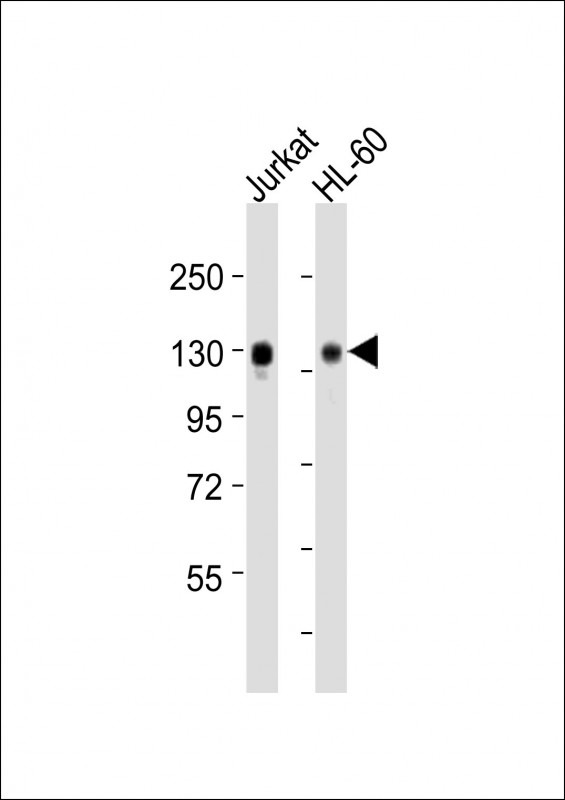SEMA4D Antibody (C-term)
Purified Rabbit Polyclonal Antibody (Pab)
- 产品详情
- 实验流程
- 背景知识
Application
| WB, E |
|---|---|
| Primary Accession | Q92854 |
| Reactivity | Human, Mouse |
| Host | Rabbit |
| Clonality | polyclonal |
| Isotype | Rabbit IgG |
| Calculated MW | 96150 Da |
| Gene ID | 10507 |
|---|---|
| Other Names | Semaphorin-4D, A8, BB18, GR3, CD100, SEMA4D, C9orf164, CD100, SEMAJ |
| Target/Specificity | This SEMA4D antibody is generated from a rabbit immunized with a KLH conjugated synthetic peptide between 793-832 amino acids from the C-terminal region of human SEMA4D. |
| Dilution | WB~~1:2000 E~~Use at an assay dependent concentration. |
| Format | Purified polyclonal antibody supplied in PBS with 0.09% (W/V) sodium azide. This antibody is purified through a protein A column, followed by peptide affinity purification. |
| Storage | Maintain refrigerated at 2-8°C for up to 2 weeks. For long term storage store at -20°C in small aliquots to prevent freeze-thaw cycles. |
| Precautions | SEMA4D Antibody (C-term) is for research use only and not for use in diagnostic or therapeutic procedures. |
| Name | SEMA4D |
|---|---|
| Synonyms | C9orf164, CD100, SEMAJ |
| Function | Cell surface receptor for PLXNB1 and PLXNB2 that plays an important role in cell-cell signaling (PubMed:20877282). Regulates GABAergic synapse development (By similarity). Promotes the development of inhibitory synapses in a PLXNB1-dependent manner (By similarity). Modulates the complexity and arborization of developing neurites in hippocampal neurons by activating PLXNB1 and interaction with PLXNB1 mediates activation of RHOA (PubMed:19788569). Promotes the migration of cerebellar granule cells (PubMed:16055703). Plays a role in the immune system; induces B-cells to aggregate and improves their viability (in vitro) (PubMed:8876214). Induces endothelial cell migration through the activation of PTK2B/PYK2, SRC, and the phosphatidylinositol 3-kinase-AKT pathway (PubMed:16055703). |
| Cellular Location | Cell membrane; Single-pass type I membrane protein |
| Tissue Location | Strongly expressed in skeletal muscle, peripheral blood lymphocytes, spleen, and thymus and also expressed at lower levels in testes, brain, kidney, small intestine, prostate, heart, placenta, lung and pancreas, but not in colon and liver |
For Research Use Only. Not For Use In Diagnostic Procedures.
Provided below are standard protocols that you may find useful for product applications.
BACKGROUND
Cell surface receptor for PLXN1B and PLXNB2 that plays an important role in cell-cell signaling. Promotes reorganization of the actin cytoskeleton and plays a role in axonal growth cone guidance in the developing central nervous system. Regulates dendrite and axon branching and morphogenesis. Promotes the migration of cerebellar granule cells and of endothelial cells. Plays a role in the immune system; induces B-cells to aggregate and improves their viability (in vitro). Promotes signaling via SRC and PTK2B/PYK2, which then mediates activation of phosphatidylinositol 3-kinase and of the AKT1 signaling cascade. Interaction with PLXNB1 mediates activation of RHOA.
REFERENCES
Hall K.T.,et al.Proc. Natl. Acad. Sci. U.S.A. 93:11780-11785(1996).
Humphray S.J.,et al.Nature 429:369-374(2004).
Ota T.,et al.Nat. Genet. 36:40-45(2004).
Tamagnone L.,et al.Cell 99:71-80(1999).
Basile J.R.,et al.Mol. Cell. Biol. 25:6889-6898(2005).
终于等到您。ABCEPTA(百远生物)抗体产品。
点击下方“我要评价 ”按钮提交您的反馈信息,您的反馈和评价是我们最宝贵的财富之一,
我们将在1-3个工作日内处理您的反馈信息。
如有疑问,联系:0512-88856768 tech-china@abcepta.com.























 癌症的基本特征包括细胞增殖、血管生成、迁移、凋亡逃避机制和细胞永生等。找到癌症发生过程中这些通路的关键标记物和对应的抗体用于检测至关重要。
癌症的基本特征包括细胞增殖、血管生成、迁移、凋亡逃避机制和细胞永生等。找到癌症发生过程中这些通路的关键标记物和对应的抗体用于检测至关重要。 为您推荐一个泛素化位点预测神器——泛素化分析工具,可以为您的蛋白的泛素化位点作出预测和评分。
为您推荐一个泛素化位点预测神器——泛素化分析工具,可以为您的蛋白的泛素化位点作出预测和评分。 细胞自噬受体图形绘图工具为你的蛋白的细胞受体结合位点作出预测和评分,识别结合到自噬通路中的蛋白是非常重要的,便于让我们理解自噬在正常生理、病理过程中的作用,如发育、细胞分化、神经退化性疾病、压力条件下、感染和癌症。
细胞自噬受体图形绘图工具为你的蛋白的细胞受体结合位点作出预测和评分,识别结合到自噬通路中的蛋白是非常重要的,便于让我们理解自噬在正常生理、病理过程中的作用,如发育、细胞分化、神经退化性疾病、压力条件下、感染和癌症。






